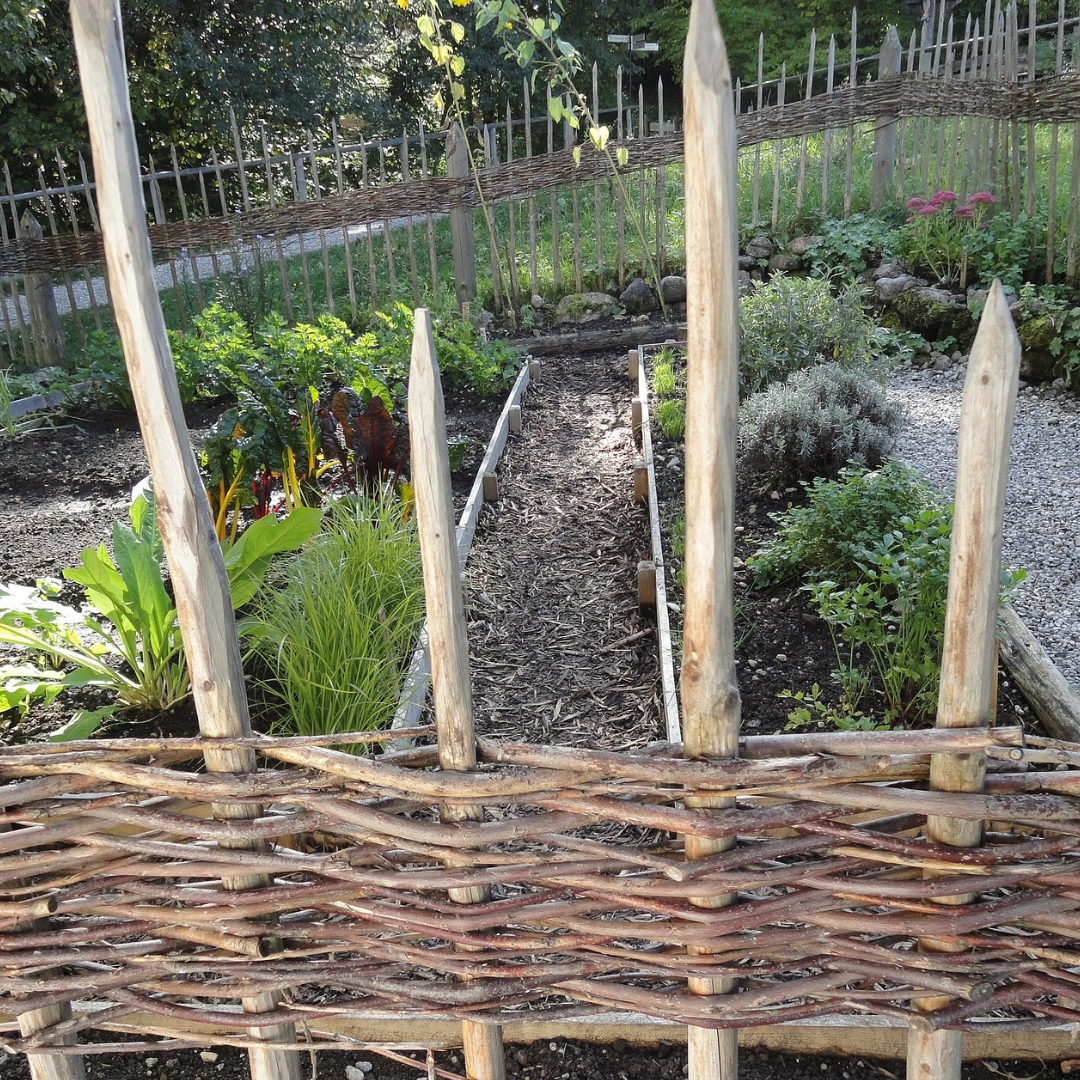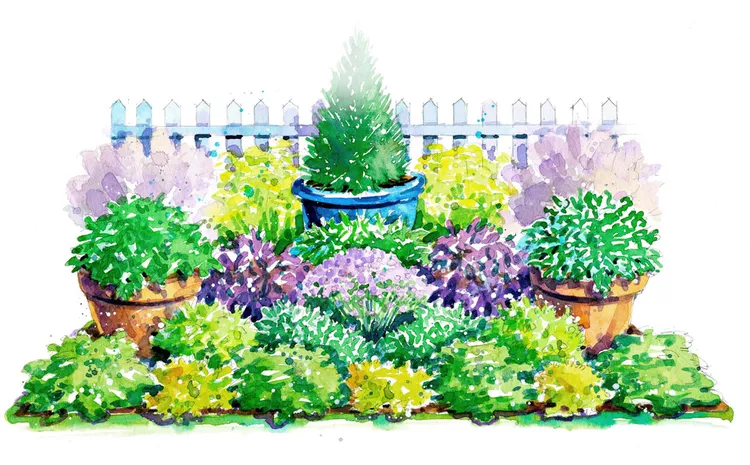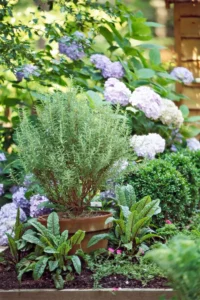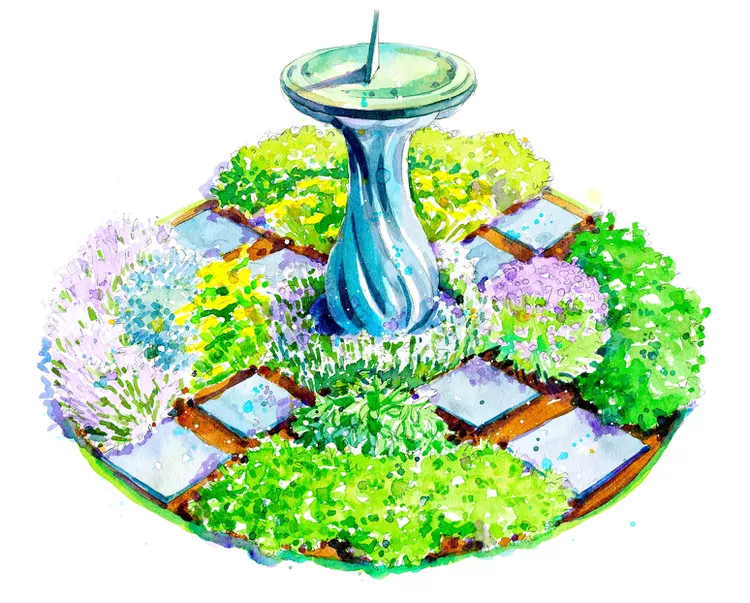
Better Homes and Gardens Online is an invaluable resource–esspecially in terms of its database of free garden plans. Following are some BHG’s plans for Herb Gardens.

Colorful Herb Garden
Image Credit Better Homes and Gardens Online
“Aromatic plants can be pleasing to the nose and the eyes alike. This colorful herb garden plan mixes foliage of different colors and textures to create a stunning and fragrant display. Rosemary planted in a beautiful container is the focal point of this design, but you can add even more flair to it by shaping its needlelike leaves into an attractive topiary. Containers of spearmint and peppermint flank the rosemary, which further help to give the garden a little height, while also keeping these rambunctious plants from getting out of hand. Weeds are limited and soil is protected by fragrant, low groundcovers such as curly parsley, lemon thyme, golden sage, and variegated oregano.” BHG Online

Colorful Herb Garden
Image Credit Better Homes and Gardens Online
 Colorful Herb Garden
Colorful Herb Garden
Image Credit Better Homes and Gardens Online
Herb Garden Plan

Rosemary
Image Credit Better Homes and Gardens Online
“Known for its scent and flavor, rosemary can be planted as an herb or a garden ornamental. This perennial evergreen shrub, hardy in Zones 8-10, can be grown as an annual in other climates. It grows quickly and can get very big.
“The best time to harvest your rosemary is in the morning, just after any dew has evaporated. You can snip stems throughout the growing season to use fresh, or cut a bunch to dry in the fall. To use rosemary, strip the needlelike leaves from the stems and chop before adding to dishes. Store fresh rosemary up to one week in the refrigerator by placing the stems in a plastic bag with a damp paper towel.
“Pulverize the dry leaves before adding them to dishes, herb blends, or sauces so the aromatic oils are released, and they’re easier to chew. Rosemary’s texture and flavor vary throughout the season—leaves are tender in the spring, with fewer aromatic oils. By late summer, the foliage packs a more potent flavor.
Rosemary Overview
| Genus Name | Rosmarinus officinalis |
| Common Name | Rosemary |
| Plant Type | Herb, Perennial, Shrub |
| Light | Sun |
| Height | 1 to 3 feet |
| Width | 2 to 4 feet |
| Flower Color | Blue, Pink, Purple, White |
| Foliage Color | Blue/Green |
| Season Features | Spring Bloom, Summer Bloom, Winter Interest |
| Zones | 10, 8, 9 |
| Propagation | Seed, Stem Cuttings |
| Problem Solvers | Deer Resistant, Drought Tolerant, Groundcover, Slope/Erosion Control |
Where to Plant Rosemary
“Because of their Mediterranean heritage, these plants thrive in hot and dry weather. Grow rosemary near paths and walkways to release its fragrance as you brush past it. Plant it where there’s lots of sunshine, away from any taller plants that could block the light.
“The needle-like texture of its leaves makes rosemary an interesting addition to mixed borders among plants with broad or strappy leaves.
How and When to Plant Rosemary
“Plant rosemary in the spring, once the weather has warmed up after the final frost. Plants should be 2 to 3 feet apart, and seeds planted with just a dusting of soil on them. To plant a potted rosemary, dig a hole about the same width and depth as the planting container. Remove the plant and loosen the roots a bit from the root ball before placing in the hole. Backfill with soil, tamp lightly, and water well.
“If you plan to grow it indoors, rosemary can be planted anytime. It may need supplemental light if there’s not enough bright light coming through windows. You’ll know rosemary needs light when it gets leggy.
Rosemary Care Tips
“Rosemary is an easy herb to care for and fungus-resistant in the right environment.
Light
“Rosemary thrives in full sun. Part sun drastically increases the likelihood of problems with fungi.
Soil and Water
“Rosemary needs well-drained, slightly acidic-to-neutral soil to survive. It will slowly suffer in heavy and moist clays, especially during winter. Water regularly, but don’t overwater since rosemary doesn’t thrive in soggy soil. When topsoil is dry, it’s time for watering. Once plants are established, they’re drought-tolerant.
“When growing potted rosemary indoors, it’s important to get the watering cadence just right. The soil should be moist but not water-logged.
Temperature and Humidity
“Dry, hot air is best for rosemary. Humidity can create problems with fungi, especially if plants are too close together. They won’t survive cold weather (under 30ºF) but can take the heat. The best temperatures for rosemary are between 55ºF and 85ºF.
Fertilizer
“Before planting, add a few inches of aged compost or other rich organic matter into the soil. Fertilize rosemary in spring and summer with an organic, high-nitrogen fertilizer. For the amount to use, follow product label directions. Avoid chemical fertilizers, especially if you plan to cook with cuttings from your rosemary plant.
Pruning
“Prune rosemary to your preferred size and style, including topiary designs. Pruning will make the plant bushier. However, don’t prune more than a third of the plant at a time because it can cause stress.” Better Homes and Gardens Online

Classic Herb Garden
Image Credit: Better Homes and Gardens Online
“Growing herbs means you’ll always have a fresh supply of delicious flavors and pleasant scents whenever you need them. Many of these plants are also quite attractive, especially when carefully selected and arranged to show off their beauty, as in this plan. This classic herb garden idea features several easy-to-grow aromatic plants that are pleasing to the eyes and nose alike.
“The design echoes a theme used by medieval monks for their apothecary gardens: a circle around a cross. A sundial in the center of the bed is also a traditional element and acts as an elegant focal point. You can use the stepping stone path to easily access and maintain the plants around it. Harvest the herbs just before they bloom for the best flavor.” Better Homes and Gardens Online
Plants for Creating the Classic Herb Garden Plan
 Classic Herb Garden
Classic Herb Garden
Image Credit: Better Homes and Gardens Online

Classic Herb Garden
Image Credit: Better Homes and Gardens Online
- 3 Creeping rosemary (Rosmarinus officinalis’ Prostratus’): Zones 7-9
- 1 Sage (Salvia officinalis ‘Berggarten’): Zones 5-8
- 1 Fennel (Foeniculum vulgare): Zones 4-9
- 4 English thyme (Thymus vulgaris): Zones 5-9
- 3 Boxwood basil (Ocimum basilicum ‘Boxwood’): Annual
- 1 Dill (Anethum graveolens): Zones 2-11
- 3 Curly parsley (Petroselinum crispum): Annual
- 1 Chives (Allium schoenoprasum): Zones 4-8
- 3 Greek oregano (Origanum vulgare subsp. hirtum): Zones 4-8
- 1 Genovese basil (Ocimum basilicum ‘Genovese’): Annual
Discover more from Jacki Kellum
Subscribe to get the latest posts sent to your email.